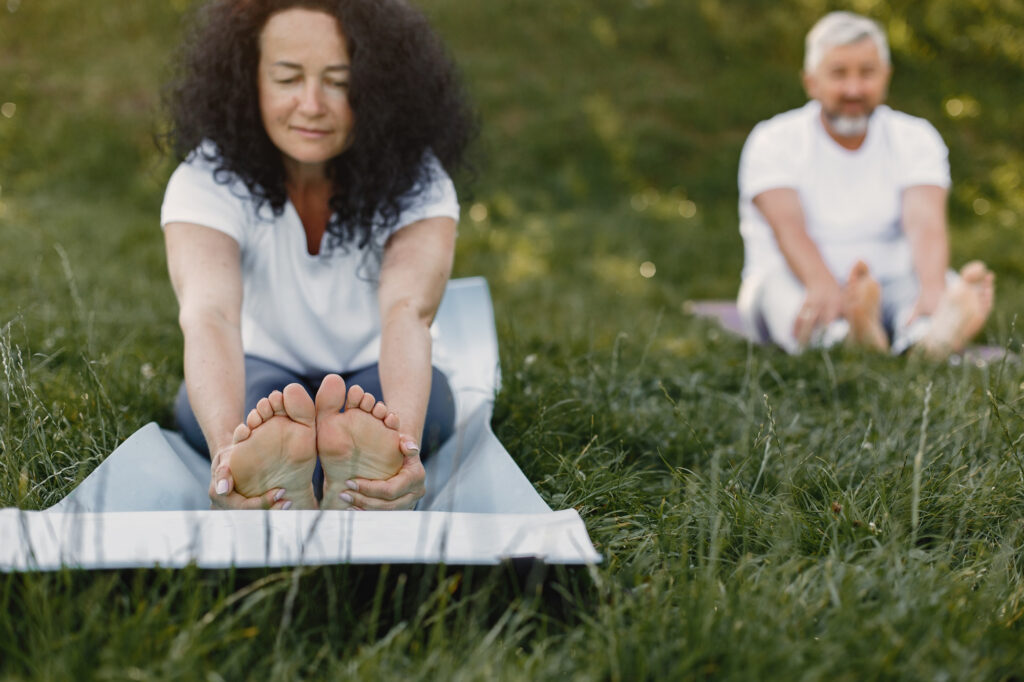
Have you ever stood amongst towering trees, inhaled the crisp forest air, and felt a sense of calm wash over you? Imagine stepping away from the screens, the noise, and the constant hustle, and immersing yourself in the calming embrace of nature. There’s a reason for that! Nature has a profound impact on our well-being, and practices like forest bathing and nature therapy are gaining popularity as ways to harness its power.
In this article, we’ll delve into the world of forest bathing and nature therapy. We’ll explore their origins, benefits, and how you can experience them for yourself.
What is Forest Bathing?
Forest bathing, also known as Shinrin-Yoku (meaning “forest bath” in Japanese), originated in Japan in the 1980s. It’s not about literally bathing in a forest (although a refreshing dip in a natural pool might be part of the experience in some places!). Forest bathing is about slowing down, disconnecting from technology, and simply being present in the atmosphere of a forest.
Here’s the key idea: slow down, disconnect from technology, and simply be present in nature. Engage your senses by:
- Inhaling the fresh, earthy scents of the forest.
- Listening to the sounds of birds chirping, leaves rustling, and a gentle breeze.
- Feeling the soft earth beneath your feet or the cool touch of bark on a tree.
- Observing the vibrant colors of leaves, the sunlight filtering through the trees, and the fascinating textures of nature.
Also Read: 7 Effective Strategies For A Digital Detox: A Comprehensive Guide
What is Nature Therapy?
Nature therapy is a broader term encompassing various practices that utilize nature to improve mental and physical health. It can include forest bathing, guided walks in nature, mindfulness exercises in natural settings, and even gardening. Nature therapy sessions are often led by trained professionals who create a safe and supportive environment for participants to connect with nature.


The Science Behind Forest Bathing and Nature Therapy
Research suggests that spending time in nature offers a range of benefits, including:
- Reduced stress and anxiety: Studies show that forest bathing can lower stress hormones like cortisol and promote relaxation.
- Improved mood and well-being: Nature exposure can boost feelings of happiness, optimism, and overall well-being.
- Enhanced focus and attention: Being in nature can improve our ability to concentrate and reduce mental fatigue.
- Boosted immune system: Studies suggest that time in nature might increase white blood cell production, which aids the immune system.
- Lowered blood pressure and heart rate: Forest bathing has been shown to lower blood pressure and heart rate, contributing to cardiovascular health.
Also Read: 6 Effective Strategies of How to Cope with Holiday Stress and Depression
Forest Bathing vs. Nature Therapy: What’s the Difference?
Think of forest bathing as a specific, focused “dip” in a particular “nature pool.” You’re immersing yourself in the atmosphere of a forest through your senses. Nature therapy, on the other hand, is a more expansive exploration of the healing powers of the natural world. It can encompass a wider range of activities and environments, including guided walks, mindfulness exercises, or even spending time in your own backyard.
Benefits of Forest Bathing and Nature Therapy:
Research suggests that spending time in nature offers a range of benefits, including:
- Reduced stress and anxiety: Studies show that forest bathing can lower stress hormones like cortisol and promote relaxation.
- Improved mood and well-being: Nature exposure can boost feelings of happiness, optimism, and overall well-being.


- Enhanced focus and attention: Being in nature can improve our ability to concentrate and reduce mental fatigue.
- Boosted immune system: Studies suggest that time in nature might increase white blood cell production, which aids the immune system.
- Lowered blood pressure and heart rate: Forest bathing has been shown to lower blood pressure and heart rate, contributing to cardiovascular health.
Ready to Experience Forest Bathing or Nature Therapy?
Here’s how to get started:
- Find a Local Forest or Nature Preserve: Check with your local parks department or use online resources like AllTrails or National Geographic [invalid URL removed] to find nearby forests or nature preserves.
- Plan a Forest Bathing Trip: Set aside dedicated time to unplug from technology, dress comfortably in weather-appropriate clothing, and pack essentials like water and snacks.
- Engage Your Senses: Disconnect from your phone and focus on the sights, sounds, smells, textures, and feelings of the forest. Walk slowly, breathe deeply, and be present in the moment.
- Join a Guided Nature Therapy Session: Consider joining a guided nature therapy session led by a trained professional. They can lead you through activities designed to enhance your connection with nature and maximize the benefits.
- Nature in Your Backyard: Even a small backyard or local park can offer some of the benefits of nature. Sit on a bench, listen to the birdsong, and appreciate the green space around you.
Tips for a Rewarding Forest Bathing or Nature Therapy Experience
- Leave technology behind: Disconnect from your phone and other devices to maximize your immersion in the natural world.
- Dress comfortably and appropriately: Comfortable shoes and weather-appropriate clothing will ensure a more enjoyable experience.
- Respect the environment: Leave no trace and follow all park rules and regulations.
- Be present: Focus on the sights, sounds, smells, and feelings of nature around you.
- Go at your own pace: There’s no right or wrong way to experience forest bathing or nature therapy. Relax, breathe deeply, and enjoy the moment.
Where Can I Do Forest Bathing or Nature Therapy?
The beauty of these practices is that they can be done almost anywhere with access to nature. Here are some ideas:
- Local Parks and Forests: Most communities have local parks or forests you can explore.
- National Parks and Forests: The United States boasts a vast network of stunning national parks and forests offering diverse natural landscapes for forest bathing. Some popular options include:
- Yosemite National Park (California): Towering sequoia trees, cascading waterfalls, and breathtaking views provide a majestic backdrop for forest bathing.
- Redwood National and State Parks (California): Immerse yourself amongst towering redwoods, some of the tallest trees on Earth, and experience the awe-inspiring beauty of these ancient giants.
- Great Smoky Mountains National Park (North Carolina & Tennessee): Lush forests, cascading waterfalls, and diverse wildlife create a serene environment for forest bathing in the heart of the Appalachian Mountains.
- Rocky Mountain National Park (Colorado): Hike through alpine meadows, breathe in the crisp mountain air, and soak in the panoramic views of the Rocky Mountains.
- Everglades National Park (Florida): Explore a unique ecosystem teeming with wildlife, from alligators and crocodiles to exotic birds and plant life.
- Nature Preserves and Botanical Gardens: Many cities and towns have dedicated nature preserves or botanical gardens that offer well-maintained trails and peaceful environments for forest bathing.
- Your Backyard or Local Green Space: Even a small backyard or neighborhood park can offer the benefits of nature therapy. Sit on a bench, listen to the birdsong, observe the changing seasons, and appreciate the calming presence of nature close to home.
Finding Guided Forest Bathing or Nature Therapy Sessions:
For a more structured experience, consider joining a guided forest bathing or nature therapy session. Here are some resources to help you find one:
- The Association of Nature and Forest Therapy (ANFT): https://www.anft.earth/ – This organization provides a directory of certified nature and forest therapy guides across the USA.
- The American Hiking Society: [https://americanhiking.org/] – The AHS website often lists guided nature walks and hikes led by experienced professionals.
- Local Wellness Centers or Yoga Studios: Many wellness centers or yoga studios offer nature therapy programs or workshops.
- Online Search: A simple online search using terms like “guided forest bathing near me” or “nature therapy sessions [your city]” can reveal available options in your area.
Remember: Forest bathing and nature therapy are not meant to be a replacement for professional medical care. If you’re struggling with mental or physical health challenges, consult with a doctor or therapist. However, these practices can be a valuable addition to your overall well-being plan.
So, lace up your walking shoes, pack a water bottle, and step outside. The world of nature awaits, ready to offer you a sense of calm, a boost to your well-being, and a reconnection with the beauty that surrounds us all.
Forest Bathing & Nature Therapy: Frequently Asked Questions
- Isn’t forest bathing just a fancy way of saying “go for a walk in the woods?”
Forest bathing goes beyond a simple walk in the woods. While walking is certainly a part of the experience, the focus in forest bathing is on intentional immersion in the forest atmosphere. It’s about slowing down, disconnecting from technology, and using your senses to truly connect with the sights, sounds, smells, textures, and feelings of nature. This intentional disconnection and focus on sensory experience differentiates forest bathing from a typical walk.
- Do I need any special equipment for forest bathing?
No, you don’t need any special equipment for forest bathing! Comfortable clothing and shoes appropriate for the weather are all you really need. However, some people find bringing a water bottle, a small snack, and maybe a journal or camera enhances the experience.
- How long does a forest bathing session typically last?
There’s no set time limit for forest bathing. The idea is to be present in the moment and allow yourself to unwind. A good starting point could be 30-60 minutes, but you can certainly go longer or shorter depending on your preferences and available time.
- What if I don’t have access to a forest? Can I still experience nature therapy?
Absolutely! While forests offer a particularly immersive environment, the benefits of nature therapy can be experienced anywhere with access to nature. Even a small park, your backyard, or a local botanical garden can provide the opportunity to connect with nature. Focus on being present in the moment, engaging your senses, and appreciating the green space around you.
- Is forest bathing safe?
Forest bathing is generally a very safe activity. However, it’s important to be aware of your surroundings, dress appropriately for the weather, and follow any safety guidelines posted in the area you’re visiting. For example, if you’re in an area with wildlife, be aware of their potential presence and maintain a safe distance.
- What if I’m not comfortable walking long distances? Can I still participate in forest bathing?
Absolutely! Forest bathing isn’t about strenuous activity. You can find a comfortable spot in a park or nature preserve, sit on a bench, and focus on connecting with the natural environment around you. The key is to be present and engage your senses.
- I’m not very good at meditating or being still. Will I struggle with forest bathing?
Forest bathing isn’t about meditation in the traditional sense. It’s more about quieting your mind and allowing yourself to be present in the moment. Focus on what you see, hear, smell, touch, and feel. If your mind wanders, gently bring it back to your senses and the natural world around you.
- Is forest bathing appropriate for children?
Yes! Forest bathing can be a wonderful experience for children. It allows them to explore nature, engage their senses, and develop a connection with the environment. However, keep in mind their attention spans and adjust the activity duration accordingly. Games, scavenger hunts, or nature journaling can be fun ways to incorporate forest bathing with children.
- Can forest bathing help with specific health conditions?
Studies suggest that spending time in nature offers a range of benefits, including reduced stress and anxiety, improved mood, and a boosted immune system. These benefits can be helpful for people struggling with various health conditions, both mental and physical. However, forest bathing shouldn’t be seen as a replacement for medical treatment.
- I’m interested in learning more about nature therapy. Are there any resources available?
Absolutely! Here are a few resources to get you started:
- The Association of Nature and Forest Therapy (ANFT): https://www.anft.earth/ – This organization provides information on the benefits of nature therapy, training programs for professionals, and resources for finding a certified nature therapy guide.
- The National Institute of Health (NIH): https://www.nih.gov/ – The NIH website has a section on the health benefits of spending time in nature, with links to research studies.
- Your Local Parks Department: Many local parks departments offer guided nature walks and programs that promote connecting with nature.
By exploring these resources and stepping into the natural world, you can unlock the transformative power of forest bathing and nature therapy!

